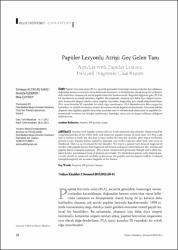| dc.contributor.author | Altıntaş Kakşi, Sümeyye | |
| dc.contributor.author | Özdemir, Mustafa | |
| dc.contributor.author | Çayırcı, Mine | |
| dc.date.accessioned | 2020-04-17T10:23:39Z | |
| dc.date.available | 2020-04-17T10:23:39Z | |
| dc.date.issued | 2013 | en_US |
| dc.identifier.citation | Altıntaş Kakşi, S., Özdemir, M. ve Çayırcı, M. (2013). Papüler lezyonlu atrişi: Geç gelen tanı. Türkiye Klinikleri Dermatoloji, 23(1), 28-31. | en_US |
| dc.identifier.issn | 1300-0330 | |
| dc.identifier.uri | https://hdl.handle.net/20.500.12511/5149 | |
| dc.description.abstract | Papüler lezyonlu atrişi (PLA), saçsızlık genindeki homozigot mutasyonlardan kaynaklanan, doğumdan hemen sonra tüm vücut kıllarında tamamen ve dönüşümsüz olarak kayıp ile içi keratin dolu kistlerden oluşmuş çok sayıda papüler lezyonla karakterizedir. Bugünkü bilgimize göre, PLA’da kıl büyümesini uyarmak mümkün değildir. Bu çalışmada, alopesisi için daha önce alopesi üniversalis, konjenital alopesi tanıları almış, papüler lezyonları alopesiden ayrı olarak değerlendirilmiş, PLA tanısı konulan 55 yaşındaki bir erkek olgu sunulmuştur. PLA düşünülenden daha yaygın bir hastalıktır ve sıklıkla otoimmün alopesi üniversalis olarak değerlendirilmektedir. Üniversal şekilde alopesisi olan olguların papüler lezyonlar açısından tam bir dermatolojik muayenesi ve papülden histopatolojik inceleme için biyopsi yapılmasının hastalığın tanısı için en uygun yaklaşım olduğunu düşünüyoruz. | en_US |
| dc.description.abstract | Atrichia with papular lesions (APL) is a rare inherited skin disorder characterized by congenital atrichia of the whole body and numerous papular lesions. In most cases the fetal scalp hair is normal at birth, but this hair is shed within the first few months, after which no further growth occurs. Papular lesions caused by follicular cyst on the scalp and other body sites occur at childhood. There is no treatment for this disorder. We report a patient with delayed diagnosis of atrichia with papular lesions that diagnosed and treated as alopecia universalis and also atrichia and papular lesions evaluated seperately. APL is more common than previously thought and is often mistaken for the autoimmune form of alopecia universalis. We think that a patient with alopecia universalis should be examined carefully to determine the papules and the papule could be evaluated histopathologically for accurate diagnosis of the disease. | en_US |
| dc.language.iso | tur | en_US |
| dc.rights | info:eu-repo/semantics/openAccess | en_US |
| dc.subject | Alopesi | en_US |
| dc.subject | HP Protein | en_US |
| dc.subject | İnsan | en_US |
| dc.subject | Alopecia | en_US |
| dc.subject | HP Protein | en_US |
| dc.subject | Human | en_US |
| dc.title | Papüler lezyonlu atrişi: Geç gelen tanı | en_US |
| dc.title.alternative | Atrichia with papular lesions: Delayed diagnosis: Case report | en_US |
| dc.type | article | en_US |
| dc.relation.ispartof | Türkiye Klinikleri Dermatoloji | en_US |
| dc.department | İstanbul Medipol Üniversitesi, Tıp Fakültesi, Dahili Tıp Bilimleri Bölümü, Deri ve Zührevi Hastalıklar Ana Bilim Dalı | en_US |
| dc.authorid | 0000-0002-7022-913X | en_US |
| dc.identifier.volume | 23 | en_US |
| dc.identifier.issue | 1 | en_US |
| dc.identifier.startpage | 28 | en_US |
| dc.identifier.endpage | 31 | en_US |
| dc.relation.publicationcategory | Makale - Uluslararası Hakemli Dergi - Kurum Öğretim Elemanı | en_US |
| dc.identifier.scopusquality | Q4 | en_US |


















